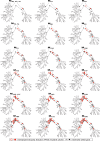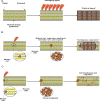Cell migration leads to spatially distinct but clonally related airway cancer precursors
- PMID: 24550057
- PMCID: PMC4033139
- DOI: 10.1136/thoraxjnl-2013-204198
Cell migration leads to spatially distinct but clonally related airway cancer precursors
Abstract
Background: Squamous cell carcinoma of the lung is a common cancer with 95% mortality at 5 years. These cancers arise from preinvasive lesions, which have a natural history of development progressing through increasing severity of dysplasia to carcinoma in situ (CIS), and in some cases, ending in transformation to invasive carcinoma. Synchronous preinvasive lesions identified at autopsy have been previously shown to be clonally related.
Methods: Using autofluorescence bronchoscopy that allows visual observation of preinvasive lesions within the upper airways, together with molecular profiling of biopsies using gene sequencing and loss-of-heterozygosity analysis from both preinvasive lesions and from intervening normal tissue, we have monitored individual lesions longitudinally and documented their visual, histological and molecular relationship.
Results: We demonstrate that rather than forming a contiguous field of abnormal tissue, clonal CIS lesions can develop at multiple anatomically discrete sites over time. Further, we demonstrate that patients with CIS in the trachea have invariably had previous lesions that have migrated proximally, and in one case, into the other lung over a period of 12 years.
Conclusions: Molecular information from these unique biopsies provides for the first time evidence that field cancerisation of the upper airways can occur through cell migration rather than via local contiguous cellular expansion as previously thought. Our findings urge a clinical strategy of ablating high-grade premalignant airway lesions with subsequent attentive surveillance for recurrence in the bronchial tree.
Keywords: Airway Epithelium; Lung Cancer.
Published by the BMJ Publishing Group Limited. For permission to use (where not already granted under a licence) please go to http://group.bmj.com/group/rights-licensing/permissions.
Figures






Similar articles
-
Extensive areas of aneuploidy are present in the respiratory epithelium of lung cancer patients.Br J Cancer. 1996 Jan;73(2):203-9. doi: 10.1038/bjc.1996.36. Br J Cancer. 1996. PMID: 8546907 Free PMC article.
-
Natural history of bronchial preinvasive lesions.Cancer Metastasis Rev. 2010 Mar;29(1):5-14. doi: 10.1007/s10555-010-9214-7. Cancer Metastasis Rev. 2010. PMID: 20112052 Free PMC article. Review.
-
p53 mutation and protein accumulation during multistage human esophageal carcinogenesis.Cancer Res. 1992 Nov 1;52(21):6092-7. Cancer Res. 1992. PMID: 1394236
-
High resolution chromosome 3p allelotyping of human lung cancer and preneoplastic/preinvasive bronchial epithelium reveals multiple, discontinuous sites of 3p allele loss and three regions of frequent breakpoints.Cancer Res. 2000 Apr 1;60(7):1949-60. Cancer Res. 2000. PMID: 10766185
-
Preinvasive disease of the airway.Cancer Treat Rev. 2017 Jul;58:77-90. doi: 10.1016/j.ctrv.2017.05.009. Epub 2017 Jul 10. Cancer Treat Rev. 2017. PMID: 28704777 Review.
Cited by
-
The actin cytoskeleton: Morphological changes in pre- and fully developed lung cancer.Biophys Rev (Melville). 2022 Dec 30;3(4):041304. doi: 10.1063/5.0096188. eCollection 2022 Dec. Biophys Rev (Melville). 2022. PMID: 38505516 Free PMC article. Review.
-
Epithelial cell migration as a potential therapeutic target in early lung cancer.Eur Respir Rev. 2017 Jan 31;26(143):160069. doi: 10.1183/16000617.0069-2016. Print 2017 Jan. Eur Respir Rev. 2017. PMID: 28143875 Free PMC article. Review.
-
Deciphering the genomic, epigenomic, and transcriptomic landscapes of pre-invasive lung cancer lesions.Nat Med. 2019 Mar;25(3):517-525. doi: 10.1038/s41591-018-0323-0. Epub 2019 Jan 21. Nat Med. 2019. PMID: 30664780 Free PMC article.
-
Matrix metalloproteinase-19 promotes metastatic behavior in vitro and is associated with increased mortality in non-small cell lung cancer.Am J Respir Crit Care Med. 2014 Oct 1;190(7):780-90. doi: 10.1164/rccm.201310-1903OC. Am J Respir Crit Care Med. 2014. PMID: 25250855 Free PMC article.
-
Evolution of Premalignant Disease.Cold Spring Harb Perspect Med. 2017 Dec 1;7(12):a026542. doi: 10.1101/cshperspect.a026542. Cold Spring Harb Perspect Med. 2017. PMID: 28490542 Free PMC article. Review.
References
-
- Auerbach O, Stout AP, Hammond EC, et al. Changes in bronchial epithelium in relation to cigarette smoking and in relation to lung cancer. N Engl J Med 1961;265:253–67 - PubMed
-
- Pairolero PC, Williams DE, Bergstralh EJ, et al. Postsurgical stage I bronchogenic carcinoma: morbid implications of recurrent disease. Ann Thorac Surg 1984;38:331–8 - PubMed
-
- Rubin H. Fields and field cancerization: the preneoplastic origins of cancer: asymptomatic hyperplastic fields are precursors of neoplasia, and their progression to tumors can be tracked by saturation density in culture. Bioessays 2011;33:224–31 - PubMed
-
- Graham TA, McDonald SA, Wright NA. Field cancerization in the GI tract. Future Oncol 2011;7:981–93 - PubMed
Publication types
MeSH terms
Grants and funding
LinkOut - more resources
Full Text Sources
Other Literature Sources
Medical
